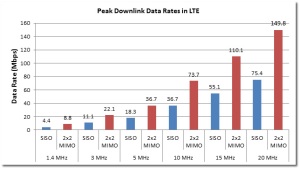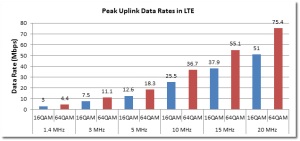LTE Peak Capacity Explained: How to Calculate it?
http://frankrayal.com/2011/06/27/lte-peak-capacity/
LTE Peak Capacity Explained: How to Calculate it?
JUNE 27, 2011 34 COMMENTS
I like to focus on LTE capacity in the next few blog entries and present what can realistically be obtained. I have seen wild figures, mainly pushed by system vendors and consumed by many operators, journalist and writers who like to wow readers of the promise of new technologies. For network operators, erring on capacity expectations has negative consequences as capacity fundamentally impact the cost of the network both on the access side and the backhaul side. Inflated capacity figures would lead to under-dimensioning on the access side and over-dimensioning on the backhaul side. So, for example, if we think LTE cell will provide 100 Mbps of throughput while in reality can only do 50 Mbps, the operator will be short by 50% of capacity in the access network resulting in poor user experience (e.g. slow download, blocking, etc.) and will be 50% over the required capacity for backhaul in which case it’s investment in capacity that’s sitting idle. This is why it is important to get capacity expectations right.
In this blog, I will look at the peak capacity of LTE. This is the maximum possible capacity which in reality can only be achieved in lab conditions. To understand the calculations below, one needs to be familiar with the technology (I will provide references at the end). But for now, let’s assume a 2×5 MHz LTE system. We first calculate the number of resource elements (RE) in a subframe (a subframe is 1 msec):
12 Subcarriers x 7 OFDMA Symbols x 25 Resource Blocks x 2 slots = 4,200 REs
Then we calculate the data rate assuming 64 QAM with no coding (64QAM is the highest modulation for downlink LTE):
6 bits per 64QAM symbol x 4,200 Res / 1 msec = 25.2 Mbps
The MIMO data rate is then 2 x 25.2 = 50.4 Mbps. We now have to subtract the overhead related to control signaling such as PDCCH and PBCH channels, reference & synchronization signals, and coding. These are estimated as follows:
- PDCCH channel can take 1 to 3 symbols out of 14 in a subframe. Assuming that on average it is 2.5 symbols, the amount of overhead due to PDCCH becomes 2.5/14 = 17.86 %.
- Downlink RS signal uses 4 symbols in every third subcarrier resulting in 16/336 = 4.76% overhead for 2×2 MIMO configuration
- The other channels (PSS, SSS, PBCH, PCFICH, PHICH) added together amount to ~2.6% of overhead
The total approximate overhead for the 5 MHz channel is 17.86% + 4.76% + 2.6% = 25.22%.
The peak data rate is then 0.75 x 50.4 Mbps = 37.8 Mbps.
Note that the uplink would have lower throughput because the modulation scheme for most device classes is 16QAM in SISO mode only.
There is another technique to calculate the peak capacity which I include here as well for a 2×20 MHz LTE system with 4×4 MIMO configuration and 64QAM code rate 1:
Downlink data rate:
- Pilot overhead (4 Tx antennas) = 14.29%
- Common channel overhead (adequate to serve 1 UE/subframe) = 10%
- CP overhead = 6.66%
- Guard band overhead = 10%
Downlink data rate = 4 x 6 bps/Hz x 20 MHz x (1-14.29%) x (1-10%) x (1-6.66%) x (1-10%) = 298 Mbps.
Uplink data rate:
1 Tx antenna (no MIMO), 64 QAM code rate 1 (Note that typical UEs can support only 16QAM)
- Pilot overhead = 14.3%
- Random access overhead = 0.625%
- CP overhead = 6.66%
- Guard band overhead = 10%
Uplink data rate = 1 * 6 bps/Hz x 20 MHz x (1-14.29%) x (1-0.625%) x (1-6.66%) x (1-10%) = 82 Mbps.
Alternative to these methods, one can refer to 3GPP document 36.213, Table 7.1.7.1-1, Table 7.1.7.2.1-1 and Table 7.1.7.2.2-1 for more accurate calculations of capacity. I have used these tables to generate the figures below for LTE peak capacity.

To conclude, the LTE capacity depends on the following:
- Channel bandwidth
- Network loading: number of subscribers in a cell which impacts the overhead
- The configuration & capability of the system: whether it’s 2×2 MIMO, SISO, and the MCS scheme.
I will address the issue of average capacity in my next blog entry. But for now, those interested in dig a little deeper on how the background for the above calculations can refer to my LTE white paper series posted at:
- http://www.eetimes.com/design/microwave-rf-design/4199671/An-overview-of-the-LTE-physical-layer-Part-I
- http://www.eetimes.com/electronics-news/4200493/An-overview-of-the-LTE-physical-layer-Part-II
- http://www.eetimes.com/design/communications-design/4204835/An-overview-of-the-LTE-physical-layer-Part-III

Comments